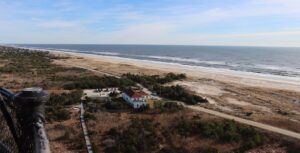On December 20, 2021, the U.S. Army Corps of Engineers (New York District), Army Corps leadership and federal, state and local officials and partners, celebrated the commencement of construction on the Fire Island to Montauk Point (FIMP) Coastal Storm Risk Management Project during a formal ceremony at Fire Island Lighthouse on Long Island’s south shore, 50 miles east of New York City.
New York District Commander Col. Matthew Luzzatto stated, “Today is a great day for Long Islanders who have been waiting many years for a project of this magnitude to reduce flood risk to their property and communities. Army Corps personnel and our federal, state, county and local partners are committed to executing this historic civil works initiative for the residents of Suffolk County.”
Construction at Fire Island
 Amidst a backdrop of construction activity, many officials—including Senator Charles (Chuck) Schumer—addressed an audience filled with many who have worked for years to make the FIMP project a reality.
Amidst a backdrop of construction activity, many officials—including Senator Charles (Chuck) Schumer—addressed an audience filled with many who have worked for years to make the FIMP project a reality.
The work currently taking place is the first contract dredging nearly 1.5 million cubic yards of sand from Fire Island Inlet and strategically placing it on area beaches to strengthen coastal resilience.
Approximately 802,000 cubic yards of sand will be placed along nearby Gilgo Beach, and 716,000 cubic yards will be placed at Robert Moses State Park, respectively. This part of the project also includes coastal process features at Robert Moses State Park to enhance shorebird habitat.
Variety of Coastal Features
The complete $1.7 billion project—including a variety of features to reduce coastal flood risk—is 100 percent federally funded through Public Law 113-2, the Emergency Supplemental Bill passed shortly after Superstorm Sandy.
Major aspects of the project include:
- Beach fill and dunes on shorefronts
- Structure elevations and building retrofits for approximately 4,400 structures
- Inlet dredging of federal navigation channels
- A four-pronged Breach Response Plan for breaches resulting from severe storms and tidal surges
- Groin/jetty reinforcement and restructuring
History of Storm Damage
Historically, mainland communities on Long Island and the barrier beaches have been repeatedly battered by severe storms and tidal surges.
Some of them include:
- 2012: Superstorm Sandy severely eroded beaches and barrier islands; several breaches were opened
- 1992: A nor’easter created two breaches of approximately 4,000 feet ─ more than 3/4 mile
- 1962: A severe storm destroyed 47 homes and inundated 12 square miles of mainland areas
- 1938: The New England Hurricane damaged and/or destroyed 57,000 homes, claiming 682 lives
Nationally Recognized
 The New York District Fire Island Inlet to Montauk Point (FIMP) Project Delivery Team (PDT) ─ an interdisciplinary team of professionals planning and designing the project ⎼ received the Army Corps’ National Outstanding Planning Achievement Team Award (Enterprise) for fiscal year 2020.
The New York District Fire Island Inlet to Montauk Point (FIMP) Project Delivery Team (PDT) ─ an interdisciplinary team of professionals planning and designing the project ⎼ received the Army Corps’ National Outstanding Planning Achievement Team Award (Enterprise) for fiscal year 2020.
This honor recognizes exceptional team efforts on specifically-authorized feasibility studies and executing the Army Corps’ civil works mission. The team was one of only two recognized throughout the U.S.
The team’s innovative approaches to water-resource planning and inter-agency collaboration resulted in the completion of a nearly four-decade planning effort and approval of a Chief of Engineer’s Report in July 2020 for the FIMP Coastal Storm Risk Management Reformulation Study, an updated version that captures current science and engineering.
All photos courtesy of USACE – New York District.

